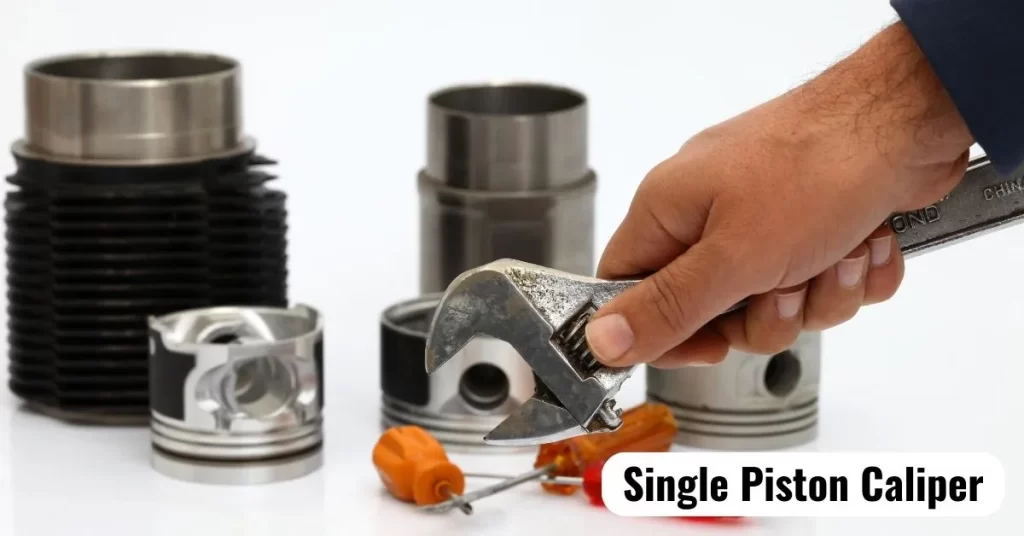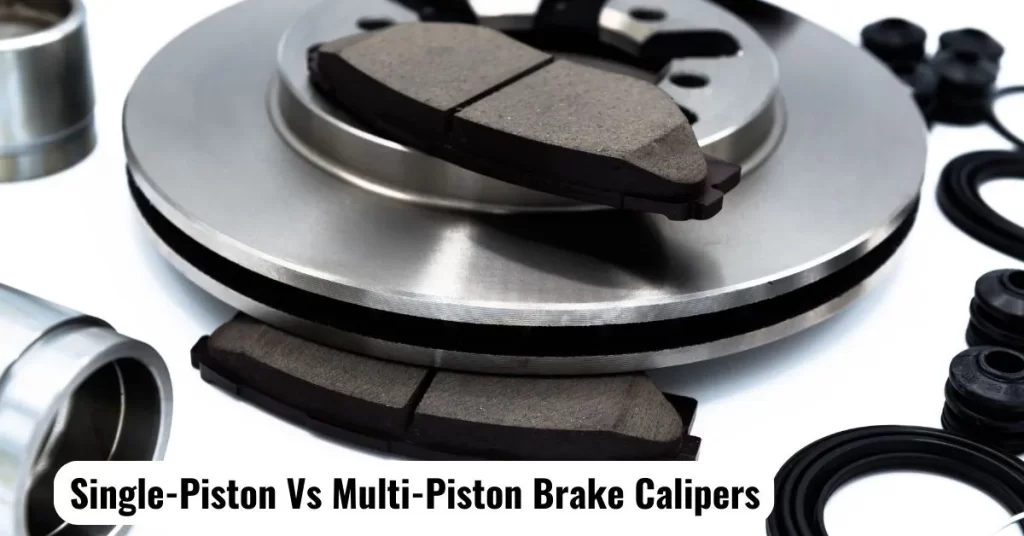Single-Piston Vs Multi-Piston Brake Calipers: Benefits And Drawbacks
One of the key components of braking systems in vehicles is the brake caliper, which houses the brake pads and applies the necessary force to stop the vehicle. Brake calipers can be categorized into two main types: single-piston and multi-piston calipers. Each type has its benefits and drawbacks, influencing factors such as braking performance, heat dissipation, complexity, and cost.
Understanding the differences between single-piston and multi-piston brake calipers is crucial for making informed vehicle upgrades or maintenance decisions. In this discussion, we will explore the advantages and disadvantages of each caliper type, shedding light on the factors that impact their performance and functionality.
Table of Contents
About Single Piston Caliper

The single-piston caliper is a floating caliper that manages a vehicle’s braking force. When you push against the brake pedal, it extends the piston, pressing against the pad and then against the rotor. This action also pulls on the other pad, stopping the car. Floating calipers use greased pins to move back and forth when brakes are applied or released.
However, the single-piston calipers have their limitations because applying brakes causes friction, leading to heat build-up over time. This process acts as a large heatsink within the system that dissipates some of that energy undertaken during braking, reducing stopping power slightly due to its design but providing excellent durability in exchange.
This fair tradeoff makes it highly popular among vehicle owners and mechanics as they ensure safety while not compromising longevity even after thousands of miles driven.
Benefits of Single Piston Caliper
- Simplicity: Single-piston calipers are relatively simple in design and construction, which makes them less expensive to manufacture and maintain than more complex braking systems.
- Lightweight: They are also generally lighter in weight, which can improve the vehicle’s overall performance and fuel efficiency.
- Lower Cost: They have fewer parts, so replacing or repairing can be more affordable.
Disadvantages of Single Piston Caliper
- Limited force: Single-piston calipers may not provide as much stopping power as more advanced braking systems, which can disadvantage high-performance vehicles or situations requiring rapid deceleration.
- Uneven Wear: The single-piston design can lead to uneven wear on the brake pads and rotors, which may require more frequent maintenance or replacement.
- Less Consistent Braking: Compared to multi-piston calipers, single-piston calipers might offer less consistent braking performance due to less even pressure distribution.
About Multi-Piston Caliper
Multi-piston calipers are an upgrade commonly used in high-performance vehicles. This type of caliper allows a much greater braking performance than the standard single-piston caliper due to its larger size and increased clamping force.
The larger caliper offers a large brake pad that can take on more heat before failing, a crucial factor in any vehicle’s braking needs. Additionally, having multiple pistons pushing pads into the rotor increases the force that can be applied during a full break. This is because the opposing pistons allow for even pressure across all rotor areas instead of just one side, as with a single piston setup.
Due to having multiple pistons inside, multi-piston calipers are more expensive when needing repairs or replacements. While this increased cost may be off-putting for some, it must be kept in mind that these calipers offer better performance and reliability when braking over long distances and during periods where extra heat is built up from constant or repetitive use.
In conclusion, multi-piston calipers are preferable in vehicles where brakes must perform at their maximum capacities, such as those driving on racetracks or similar venues.
Benefits of Multi-Piston Caliper
- Increased Braking Force: Multi-piston calipers provide greater braking force and better stopping power, making them ideal for high-performance vehicles that require more precise and aggressive braking.
- Even Pressure Distribution: The multiple pistons in a multi-piston caliper distribute pressure evenly across the brake pad, resulting in more consistent braking performance and less wear on the pads and rotors.
- Improved Heat Dissipation: Multi-piston calipers can dissipate heat more effectively than single-piston calipers, which reduces the risk of brake fade and improves overall braking performance.
- Styling: Multi-piston calipers have a more visually striking appearance which could be considered a benefit in terms of aesthetics.
Disadvantages of Multi-Piston Caliper
- Complexity: Multi-piston calipers are more complex in design and construction, making them more expensive to manufacture and maintain.
- Weight: They are generally heavier than single-piston calipers, which can hurt vehicle performance and fuel efficiency.
- Multi-piston calipers’ additional parts, complexity, and performance improvements can make them more expensive to repair and replace.
Single-Piston Vs Multi-Piston Brake Calipers: Comparison Table

| Comparison Factors | Single-Piston Brake Calipers | Multi-Piston Brake Calipers |
|---|---|---|
| Braking Performance | Good for daily driving and light-duty applications. May exhibit less initial bite and slightly longer braking distances. | Offers improved braking performance, especially under demanding conditions. Provides better initial bite, enhanced stopping power, and shorter braking distances. |
| Heat Dissipation | Moderate heat dissipation capabilities due to limited surface area for heat dissipation. May be prone to brake fade under heavy and prolonged use. | Excellent heat dissipation due to increased surface area provided by multiple pistons. Better resistance to brake fade, allowing consistent performance under intense braking conditions. |
| Complexity | Simple design with fewer components, making them easier to manufacture and maintain. | More complex design with additional pistons and components, requiring precise calibration and potentially more maintenance. |
| Weight | Generally lighter in weight, contributing to overall weight reduction in the vehicle. | Slightly heavier due to additional pistons and components, which may impact fuel efficiency to a small extent. |
| Cost | Generally more affordable, making them a cost-effective option for basic braking needs. | Tend to be more expensive due to the increased complexity and additional components. However, prices can vary depending on the brand and specific features. |
| Application | Well-suited for everyday driving, light-duty vehicles, and non-performance applications. | Moderate heat dissipation capabilities due to limited surface area for heat dissipation. It may be prone to brake fade under heavy and prolonged use. |
Which One Should I Choose?
When selecting a brake caliper, there are two main types: single-piston and multi-piston. Both have their benefits and drawbacks, so deciding which is best for your vehicle can be difficult. To help you make an informed decision, let’s look at each type’s advantages and disadvantages.
The biggest benefit of single-piston calipers is their low cost, making them an attractive option for many budget-minded drivers.
However, these calipers are less capable of providing consistent braking performance due to uneven pressure distribution and can lead to more frequent maintenance and pad replacement.
Multi-piston calipers offer multiple advantages over single-piston designs. These include increased braking force, even pressure distribution, improved heat dissipation, and better styling. Additionally, they can help reduce the risk of brake fade during aggressive driving.
However, these calipers are more expensive due to their complexity and heavier weight. Choosing between single-piston and multi-piston calipers depends on your needs and budget. Those who are looking for a cost-effective solution may want to
What If I Have More Than One Pistons In Your Brake Calipers?
Sports cars are often seen with brakes boasting four- or even six-piston calipers, but what are the advantages of going with more pistons? Multi-piston brake calipers allow an increased force to be applied to slow the spinning brake discs.
This is achieved by having more pistons that can press onto the friction material, commonly called brake pads. Having multiple pistons also allows for a wider contact area on the disc, which helps dissipate heat during braking and can prevent overheating, ensuring your brakes are always ready when needed.
Compared to a traditional single-piston ‘floating’ setup, multi-piston setups provide increased performance and better value for money. Upgrading your current setup may be worth it if you want superior braking power with less wear and tear over time, extending reliability and safety when needed. While not all vehicles require such sophisticated systems, upgrading your car’s braking power could give it that extra edge on track days or going down steep hills.
Frequently Asked Questions [FAQs]
1. Are Two-Piston Calipers Better?
Regarding brake calipers, two-piston designs offer several advantages over single-piston versions. These advantages include improved stopping power, better heat dissipation, and a longer lifespan due to increased durability. Two-piston calipers also provide a more balanced braking force across the rotor, reducing wear on the pads and rotors. Additionally, two-piston models are typically more aesthetically pleasing and may even increase the resale value of your vehicle.
2. What Are The Benefits Of Multi-Piston Calipers?
Multi-piston calipers offer several advantages over single and two-piston designs. These include improved braking force due to increased pad area, superior heat dissipation for better-stopping performance, and more even pressure distribution across the pads and rotors. Additionally, they look great, provide superior braking power, and can help reduce the risk of brake fade during aggressive driving.
3. What Is Better Four-Piston Or 2-Piston Calipers?
When choosing the right brake caliper for your vehicle, there are two main options – single-piston or multi-piston. Each style of the caliper has its own set of benefits and drawbacks. Let’s examine what makes each unique and which one might be best for your vehicle.
4. Does More Brake Pistons Mean More Power?
When it comes to braking power, many people believe that having more brake pistons in a caliper means more stopping power. This is not necessarily true. Single-piston brake calipers are typically lighter and simpler to maintain than multi-piston calipers. Still, the actual amount of braking force generated by either type of caliper does not vary significantly.
5. Are Bigger Brake Calipers Better?
Big brake kits provide better stopping power than stock brakes due to their larger size, disc area, and more effective brake pads. The addition of braided brake cables can also contribute to improved performance.
Conclusion
The choice between single-piston and multi-piston calipers depends on your personal preference and needs. Single-piston calipers offer simple maintenance, while multi-piston models provide superior braking force and heat dissipation. Additionally, larger brakes can provide even more stopping power and improved performance. Ultimately, it is up to you to decide which type of brake system best fits your needs and budget.
